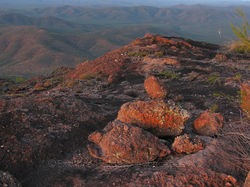top of page


A Nature Guide's -
Guide to the Wet Tropics
Mount Mulligan - Ngarrabullgan
Outside World Heritage Area.
National Heritage List 2011.
Name of Protectected Area: Ngarrabullgan
(National Heritage List 2011)
Indigenous Name: Ngarrabullgan
Name of Mountain Range: Featherbed Range
Height Above Sea Level: Highest Point 814 m
Scroll
Down &
Click on
an Image
bottom of page















